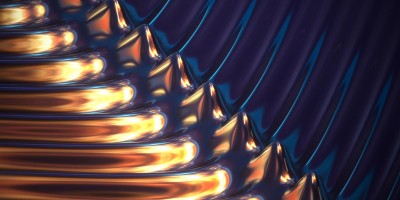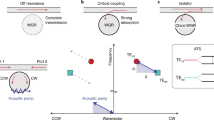Abstract
Achieving on-chip optical signal isolation is a fundamental difficulty in integrated photonics1. The need to overcome this difficulty is becoming increasingly urgent, especially with the emergence of silicon nano-photonics2,3,4, which promises to create on-chip optical systems at an unprecedented scale of integration. Until now, there have been no techniques that provide complete on-chip signal isolation using materials or processes that are fundamentally compatible with silicon CMOS processes. Based on the effects of photonic transitions5,6, we show here that a linear, broadband and non-reciprocal isolation can be accomplished by spatial–temporal refractive index modulations that simultaneously impart frequency and wavevector shifts during the photonic transition process. We further show that a non-reciprocal effect can be accomplished in dynamically modulated micrometre-scale ring-resonator structures. This work demonstrates that on-chip isolation can be accomplished with dynamic photonic structures in standard material systems that are widely used for integrated optoelectronic applications.




Similar content being viewed by others
Change history
15 April 2009
In the version of this Letter originally published, equation (4) was incorrect, as was the final sentence in the third paragraph from the end of page 92. These errors have now been corrected in the HTML and PDF versions.
References
Soljacic, M. & Joannopoulos, J. D. Enhancement of nonlinear effects using photonic crystals. Nature Mater. 3, 211–219 (2004).
Pavesi, L. & Lockwood, D. J. Silicon Photonics (Springer, 2004).
Almeida, V. R., Barrios, C. A., Panepucci, R. R. & Lipson, M. All-optical control of light on a silicon chip. Nature 431, 1081–1084 (2004).
Miller, D. A. B. Optical interconnects to silicon. IEEE J. Sel. Top. Quant. Electron. 6, 1312–1317 (2000).
Winn, J. N., Fan, S., Joannopoulos, J. D. & Ippen, E. P. Interband transitions in photonic crystals. Phys. Rev. B 59, 1551–1554 (1998).
Dong, P., Preble, S. F., Robinson, J. T., Manipatruni, S. & Lipson, M. Inducing photonic transitions between discrete modes in a silicon optical microcavity. Phys. Rev. Lett. 100, 033904 (2008).
Espinola, R. L., Izuhara, T., Tsai, M. C., Osgood, R. M. Jr & Dötsch, H. Magneto-optical nonreciprocal phase shift in garnet/silicon-on-insulator waveguides. Opt. Lett. 29, 941–943 (2004).
Levy, M. A nanomagnetic route to bias-magnet-free, on-chip Faraday rotators. J. Opt. Soc. Am. B 22, 254–260 (2005).
Zaman, T. R., Guo, X. & Ram, R. J. Faraday rotation in an InP waveguide. Appl. Phys. Lett. 90, 023514 (2007).
Dötsch, H. et al. Applications of magneto-optical waveguides in integrated optics: review. J. Opt. Soc. Am. B 22, 240–253 (2005).
Soljaic, M., Luo, C., Joannopoulos, J. D. & Fan, S. Nonlinear photonic microdevices for optical integration. Opt. Lett. 28, 637–639 (2003).
Gallo, K., Assanto, G., Parameswaran, K. R. & Fejer, M. M. All-optical diode in a periodically poled lithium niobate waveguide. Appl. Phys. Lett. 79, 314–316 (2001).
Ibrahim, S. K., Bhandare, S., Sandel, D., Zhang, H. & Noe, R. Non-magnetic 30 dB integrated optical isolator in III/V material. Electron. Lett. 40, 1293–1294 (2004).
Yariv, A. Electro-optic frequency modulation in optical resonators. Proc. IEEE 52, 719–720 (1964).
Siegman, A. Lasers 986 (University Science Books, 1986).
Reed, E. J., Soljacic, M. & Joannopoulos, J. D. Reversed Doppler effect in photonic crystals. Phys. Rev. Lett. 91, 133901 (2003).
Yanik, M. F. & Fan, S. Stopping light all-optically. Phys. Rev. Lett. 92, 083901 (2004).
Notomi, M. & Mitsugi, S. Wavelength conversion via dynamic refractive index tuning of a cavity. Phys. Rev. A 73, 051803(R) (2006).
Taflove, A. & Hagness, S. C. Computational Electrodynamics: The Finite-Difference Time-Domain Method 2nd edn (Artech House, 2000).
Preble, S. F., Xu, Q. & Lipson, M. Changing the colour of light in a silicon resonator. Nature Photon. 1, 293–296 (2007).
Jiao, Y., Fan, S. & Miller, D. A. B. Demonstrations of systematic photonic crystal design and optimization by low rank adjustment: an extremely compact mode separator. Opt. Lett. 30, 141–143 (2005).
Lee, B. T. & Shin, S. Y. Mode-order converter in a multimode waveguide. Opt. Lett. 28, 1660–1662 (2003).
Fan, S. et al. Guided and defect modes in periodic dielectric waveguides. J. Opt. Soc. Am. B 12, 1267–1272 (1995).
Acknowledgements
This work was supported in part by the National Science Foundation (grant no. ECS-0622212). S.F. acknowledges discussions with Z. Wang and M. Soljacic. The computations were performed at the Pittsburgh Supercomputing Center and the National Center for Supercomputing Applications, through the support of the National Science Foundation TeraGrid programme.
Author information
Authors and Affiliations
Corresponding author
Supplementary information
Rights and permissions
About this article
Cite this article
Yu, Z., Fan, S. Complete optical isolation created by indirect interband photonic transitions. Nature Photon 3, 91–94 (2009). https://doi.org/10.1038/nphoton.2008.273
Received:
Accepted:
Published:
Issue Date:
DOI: https://doi.org/10.1038/nphoton.2008.273
- Springer Nature Limited
This article is cited by
-
Passive bias-free non-reciprocal metasurfaces based on thermally nonlinear quasi-bound states in the continuum
Nature Photonics (2024)
-
Light control with Weyl semimetals
eLight (2023)
-
Quadrature nonreciprocity in bosonic networks without breaking time-reversal symmetry
Nature Physics (2023)
-
Broadband coherent wave control through photonic collisions at time interfaces
Nature Physics (2023)
-
Noiseless single-photon isolator at room temperature
Communications Physics (2023)





